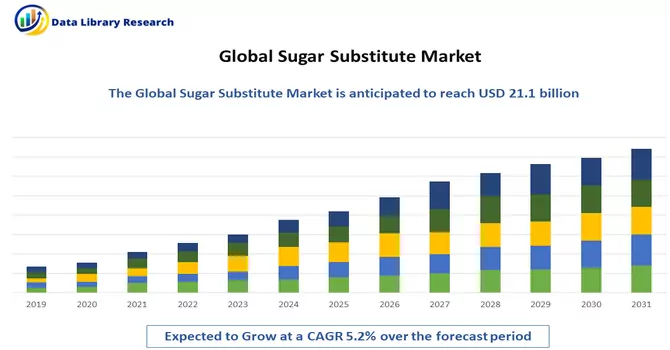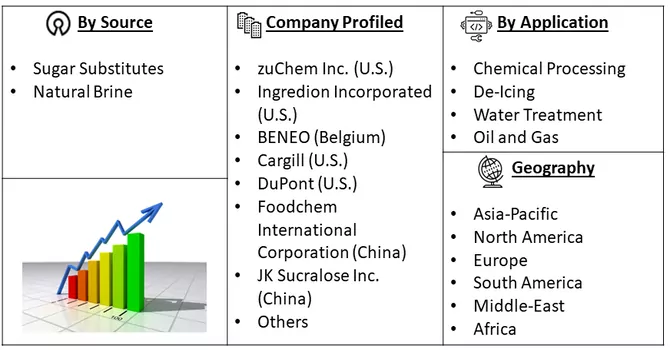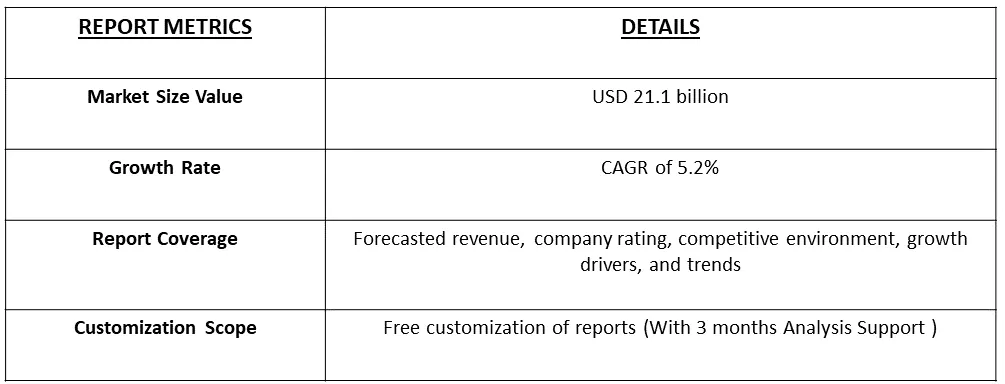The sugar substitutes market was valued at USD 21.1 billion by 2023 and is projected to register a CAGR of 5.2% from 2024 to 2031.

Get Complete Analysis Of The Report - Download Free Sample PDF
Sugar substitutes, also known as artificial sweeteners or sugar alternatives, are substances used to sweeten food and beverages without the calories and negative health effects associated with regular sugar (sucrose). Examples include artificial sweeteners like aspartame and sucralose, sugar alcohols such as xylitol and erythritol, as well as natural sweeteners like stevia and monk fruit extract. These substitutes are often chosen by individuals seeking to reduce calorie intake, manage blood sugar levels, or control weight. While they can be useful in certain contexts, moderation is advised, and consulting with healthcare professionals is recommended for those with specific health concerns.
The market is experiencing growth primarily due to shifting consumer preferences towards healthier and lower-calorie food options. This trend is a direct response to the increasing awareness of and prevalence of health issues related to obesity, notably stemming from diabetes, cardiovascular diseases, and elevated cholesterol levels. Additionally, global concerns about the potential rise in animal-borne diseases have prompted widespread health apprehensions, leading to a decline in the consumption of animal products. As individuals become more conscious of the impact of dietary choices on their well-being, the demand for alternatives and substitutes that align with health-conscious lifestyles has surged, driving the expansion of this market.
The sugar substitutes market is experiencing notable trends driven by increasing consumer preferences for healthier lifestyles and concerns about issues like obesity, diabetes, and cardiovascular diseases. The surge in popularity of low-carb and ketogenic diets has further propelled the demand for sugar substitutes as individuals seek alternatives with reduced sugar content. Environmental consciousness and ethical considerations have led to a rising preference for natural sweeteners such as stevia and monk fruit extracts. Ongoing advancements in food technology and product innovation contribute to the market's growth, with the introduction of novel substitutes aiming to enhance taste, stability, and versatility in various applications. Overall, the market is evolving in response to dynamic consumer behaviors, health awareness, dietary shifts, ethical considerations, and continuous efforts in research and development.
Market Segmentation: The Global Sugar Substitutes Market, By Source (Sugar Substitutes and Natural Brine), Application (Chemical Processing, De-Icing, Water Treatment, Oil and Gas) and by Region (Africa, Asia-Pacific, Europe, Middle East, North America, and South America). Key data points observed include the market volume of end-user segments, per capita consumption, and raw material production.

For Detailed Market Segmentation - Download Free Sample PDF
Market Drivers:
Growing Health Consciousness
An increasing awareness of the health risks associated with high sugar consumption, including obesity and diabetes, has been a significant driver for the sugar substitute market. Consumers are actively seeking healthier alternatives to traditional sugar, driving the demand for sugar substitutes as a means to manage weight and reduce the risk of related health issues.
Rising Incidence of Diabetes
The global rise in diabetes cases has propelled the demand for sugar substitutes, as individuals with diabetes often need to monitor and control their sugar intake. Sugar substitutes provide a sweetening solution without impacting blood glucose levels, making them a preferred choice for diabetic individuals, thus driving market growth.
Market Restraints:
Perceived Health Concerns and Safety Issues
Despite their widespread use, sugar substitutes have faced scrutiny and concerns related to their long-term health effects. Some studies have raised questions about the safety of certain artificial sweeteners, leading to hesitations among consumers. This perceived uncertainty regarding the safety of sugar substitutes can act as a restraint, impacting consumer confidence and adoption rates in the market. Manufacturers often need to address these concerns through transparent labeling and continued research to alleviate doubts and maintain market trust.
The COVID-19 pandemic has had a multifaceted impact on the sugar substitute market. While there has been a heightened awareness of health and wellness, prompting increased interest in sugar-free and reduced-calorie products, the market has faced challenges stemming from disruptions in supply chains, production, and distribution during lockdowns. Changes in consumer spending patterns, economic uncertainties, and shifts in purchasing priorities have influenced the demand for sugar substitutes. Additionally, the foodservice sector, a significant consumer of sugar substitutes, experienced a downturn due to restrictions on dining out. Despite the challenges, the pandemic has accelerated the trend toward healthier lifestyles, potentially fostering a long-term impact on the sugar substitute market as consumers continue to prioritize health-conscious choices in their dietary preferences.
Segmental Analysis:
Sugar Substitutes Segment is Expected to Witness Significant Growth Over the Forecast Period
Sugar substitutes, also known as artificial sweeteners or sugar alternatives, are substances used to impart sweetness to food and beverages without the caloric content associated with traditional sugars. These substitutes are gaining popularity due to various factors, including the rising global concern about health issues related to excessive sugar consumption, such as obesity, diabetes, and cardiovascular diseases. There are different types of sugar substitutes available in the market. Artificial sweeteners, such as aspartame, saccharin, sucralose, and acesulfame potassium, are synthetic compounds that provide sweetness without the calories. Sugar alcohols, including xylitol, erythritol, and sorbitol, are another category that occurs naturally in some foods or can be produced synthetically. Natural sweeteners like stevia and monk fruit extract are derived from plants and are considered alternatives with fewer or no calories. Consumers are increasingly turning to sugar substitutes as they seek to manage their calorie intake, control blood sugar levels, and adopt healthier eating habits. The market for sugar substitutes has seen continuous growth as manufacturers incorporate these alternatives into a wide range of products, including beverages, snacks, dairy, and bakery items. Additionally, the demand for sugar substitutes has been fueled by the popularity of low-carb and ketogenic diets, where reducing sugar intake is a key dietary focus. Despite the growing use of sugar substitutes, there is ongoing debate and research regarding their long-term health effects and potential implications. Some studies suggest concerns related to certain artificial sweeteners, while natural sweeteners are often perceived as more "clean label" options. As the market evolves, continued innovation in product development, improvements in taste profiles, and addressing consumer preferences for natural ingredients are likely to shape the future of sugar substitutes. It is essential for consumers to stay informed and make choices based on their individual health needs and preferences.
Water Treatment Segment is Expected to Witness Significant Growth Over the Forecast Period
Water treatment is a vital process essential for enhancing water quality for various purposes, encompassing drinking, industrial applications, and environmental preservation. It involves stages such as coagulation, sedimentation, filtration, disinfection, and pH adjustment to remove impurities and ensure compliance with safety standards. Simultaneously, the use of sugar substitutes, or artificial sweeteners, has surged due to concerns about health issues linked to excessive sugar consumption. These substitutes, ranging from artificial sweeteners like aspartame to natural alternatives such as stevia, provide sweetness without the caloric impact of traditional sugar, catering to individuals seeking weight management and blood sugar control. Both water treatment and sugar substitutes contribute significantly to overall health and well-being, addressing safety concerns in water consumption and offering alternatives for reducing sugar intake and managing related health issues.
Asia-Pacific Region is Expected to Witness Significant Growth Over the Forecast Period
The Asia Pacific region plays a pivotal role in the global sugar substitute market, witnessing dynamic trends and significant growth. The increasing prevalence of health-conscious consumer behavior, rising concerns about lifestyle diseases such as diabetes and obesity, and a growing awareness of the impact of excessive sugar consumption are driving the demand for sugar substitutes in the region. Countries like China, India, and Japan are experiencing a notable surge in the adoption of sugar substitutes as consumers seek alternatives to traditional sugars for weight management and blood sugar control. The food and beverage industry in the Asia Pacific is responding to these shifting preferences by incorporating sugar substitutes into a diverse array of products, ranging from beverages and snacks to confectionery and dairy items. Government initiatives promoting healthier lifestyles and nutrition are further contributing to the rise of sugar substitute consumption in the region. Additionally, the appeal of natural sweeteners, such as stevia and monk fruit extract, aligns with the growing preference for clean-label products, driving innovation and product development in the sugar substitute market. The Asia Pacific region also showcases a diverse range of sugar substitute preferences, with various countries emphasizing different types of sweeteners based on cultural preferences and local tastes. The market is witnessing not only the adoption of established artificial sweeteners but also an increasing interest in traditional, plant-derived sweeteners. As the demand for healthier alternatives continues to grow, the Asia Pacific sugar substitute market is positioned for sustained expansion. Manufacturers are likely to focus on research and development to introduce new and improved products, catering to the evolving tastes and health-conscious choices of consumers in this dynamic and diverse region.

Get Complete Analysis Of The Report - Download Free Sample PDF
In the competitive landscape of the global sugar substitutes market, a comprehensive overview of key players reveals crucial insights into their financial standing, market presence, and strategic initiatives. This information encompasses company profiles, financial data, revenue generation, market potential, investment in research and development, global footprint, production sites and capacities, as well as strengths and weaknesses. The competitive analysis further delves into new market initiatives, product launches, and the breadth of product offerings, along with the dominance in various applications. Notable players in the global sugar substitutes market include those making significant contributions through robust financials, extensive research and development investments, and a strong global presence. This comprehensive assessment of key competitors provides a holistic understanding of the market dynamics and the competitive strategies employed by major players in the ever-evolving sugar substitutes industry.
Recent Development:
1) In March 2022, Cargill launched its stevia products featuring the EverSweet + ClearFlo technology, introducing a refined flavor profile to enhance the sweetness experience. This innovative sweetener system integrates stevia with a distinctive flavor, offering several advantages such as flavor modification, improved dispersion, and increased solubility and stability in various compositions.
2) In April 2022, Tate & Lyle responded to a significant surge in demand for crystalline allulose by expanding its production. This increased demand was driven by the FDA's decision to exclude allulose from added and total sugar declarations on Nutrition Facts panels. Tate & Lyle highlighted the widespread utilization of allulose in various products, with a particular emphasis on its popularity in bars. This expansion reflects the industry's responsiveness to evolving regulatory landscapes and consumer preferences.
Q1. What was the Sugar Substitute Market size in 2023?
As per Data Library Research the sugar substitutes market was valued at USD 21.1 billion by 2023.
Q2. What is the Growth Rate of the Sugar Substitute Market ?
Sugar Substitute Market is projected to register a CAGR of 5.2% over the forecast period.
Q3. What are the factors driving the Sugar Substitute Market?
Key factors that are driving the growth include the Growing Health Consciousness and Rising Incidence of Diabetes.
Q4. Which Region is expected to hold the highest Market share?
Asia Pacific region is expected to hold the highest Market share.
Data Library Research are conducted by industry experts who offer insight on industry structure, market segmentations technology assessment and competitive landscape (CL), and penetration, as well as on emerging trends. Their analysis is based on primary interviews (~ 80%) and secondary research (~ 20%) as well as years of professional expertise in their respective industries. Adding to this, by analysing historical trends and current market positions, our analysts predict where the market will be headed for the next five years. Furthermore, the varying trends of segment & categories geographically presented are also studied and the estimated based on the primary & secondary research.
In this particular report from the supply side Data Library Research has conducted primary surveys (interviews) with the key level executives (VP, CEO’s, Marketing Director, Business Development Manager and SOFT) of the companies that active & prominent as well as the midsized organization
FIGURE 1: DLR RESEARH PROCESS

Extensive primary research was conducted to gain a deeper insight of the market and industry performance. The analysis is based on both primary and secondary research as well as years of professional expertise in the respective industries.
In addition to analysing current and historical trends, our analysts predict where the market is headed over the next five years.
It varies by segment for these categories geographically presented in the list of market tables. Speaking about this particular report we have conducted primary surveys (interviews) with the key level executives (VP, CEO’s, Marketing Director, Business Development Manager and many more) of the major players active in the market.
Secondary ResearchSecondary research was mainly used to collect and identify information useful for the extensive, technical, market-oriented, and Friend’s study of the Global Extra Neutral Alcohol. It was also used to obtain key information about major players, market classification and segmentation according to the industry trends, geographical markets, and developments related to the market and technology perspectives. For this study, analysts have gathered information from various credible sources, such as annual reports, sec filings, journals, white papers, SOFT presentations, and company web sites.
Market Size EstimationBoth, top-down and bottom-up approaches were used to estimate and validate the size of the Global market and to estimate the size of various other dependent submarkets in the overall Extra Neutral Alcohol. The key players in the market were identified through secondary research and their market contributions in the respective geographies were determined through primary and secondary research.
Forecast Model
